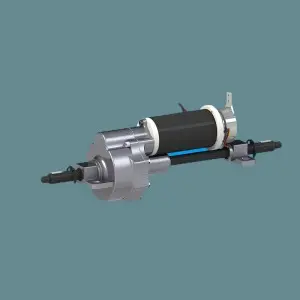The transaxle is a critical component in many vehicles, especially those with front-wheel drive. It combines the functions of a transmission and an axle to efficiently transmit power from the engine to the wheels. Given its importance, knowing when to replace your transaxle can help you save on expensive repairs and keep your vehicle running smoothly. In this article, we’ll explore the signs of transaxle failure, the replacement process, and the importance of prompt intervention.
Understand the transaxle
Before delving into the signs of transaxle failure, it’s necessary to understand what it is and how it works. The transaxle is a complex assembly that includes the transmission, differential, and transaxle. It is responsible for:
- Power Distribution: The transaxle transfers power from the engine to the wheels, allowing the vehicle to move.
- Gear Shift: It enables the driver to change gears, which is essential for acceleration and deceleration.
- Torque Management: The transaxle helps manage the torque produced by the engine, ensuring the wheels receive the appropriate amount of power.
Given its multi-faceted role, any problem with the transaxle can severely impact your vehicle’s performance.
Signs of Transaxle Failure
Recognizing the signs of transaxle failure is critical to prompt intervention. Here are some common indicators that a transaxle may need to be replaced:
1. Abnormal noise
One of the first signs of transaxle failure is the presence of unusual noises. If you hear grinding, clanking, or whining sounds when you shift gears or drive, it could indicate internal damage or wear. These noises usually indicate a faulty gear or bearing within the transaxle and may require immediate attention.
2. Liquid leakage
The transaxle relies on transmission oil for lubrication and cooling. If you notice red or brown fluid collecting under your car, this could be a sign of a leak. Low fluid levels can cause transaxle components to overheat and increase wear, ultimately leading to failure. If you suspect a leak is occurring, it’s crucial to address it promptly.
3. Gear Slip
If your vehicle unexpectedly slips out of gear while driving, that’s a sure sign that there’s a problem with the transaxle. This could happen due to worn gears, low fluid levels, or internal damage. Gear slippage can be dangerous as it can lead to loss of control while driving.
4. Delayed participation
When you shift from Park to Drive or Reverse, there should be a smooth transition. If you experience a delay in engagement, it may indicate a problem with the transaxle. This delay may be caused by low fluid levels, worn parts, or internal damage.
5. Warning light
Modern vehicles are equipped with a variety of sensors to monitor transaxle performance. If the check engine light or transmission warning light on your dashboard comes on, your vehicle must be inspected. These warning lights can indicate a range of problems, including transaxle problems.
6. Poor acceleration
If your vehicle has difficulty accelerating or feels sluggish, this could be a sign of transaxle failure. This could happen due to internal damage, low fluid levels, or driveline issues. Poor acceleration affects your driving experience and may pose safety risks.
7. burnt smell
A burning smell while driving may indicate overheating, often caused by low transmission fluid levels or internal damage. If you notice a burning smell, be sure to stop driving and have your vehicle inspected immediately. Continued driving under these conditions may cause serious damage to the transaxle.
Replacement process
If you notice signs of transaxle failure, you must consult a qualified mechanic for a thorough inspection. If replacement is required, you may encounter the following situations during the process:
1. Diagnosis
A mechanic will perform a diagnostic exam to determine the exact problem with the transaxle. This may involve checking fluid levels, checking for leaks and taking a test drive to assess performance.
2. Remove
Once a diagnosis is made, the mechanic will begin the disassembly process. This includes disconnecting the battery, draining the transmission fluid, and removing anything that blocks access to the transaxle.
3. Replacement
After the old transaxle is removed, a new or rebuilt transaxle will be installed. The mechanic will make sure all connections are tight and the new transaxle is properly aligned.
4. Liquid Replacement
Once the new transaxle is in place, the mechanic will refill the transmission fluid to the proper level. This is a crucial step, as proper lubrication is critical to transaxle performance.
5. Test
After installation, mechanics will perform a series of tests to ensure the new transaxle is functioning properly. This may involve test driving the vehicle to assess performance and shifting ability.
The importance of timely replacement
Prompt replacement of a failed transaxle is critical for several reasons:
- SAFETY: Transaxle failure can result in loss of control while driving, posing significant safety risks to you and others on the road.
- Cost Effectiveness: Addressing transaxle problems early can prevent more extensive damage, saving you money on repairs in the long run.
- Vehicle Performance: A properly functioning transaxle ensures smooth shifting and optimal power distribution, enhancing your overall driving experience.
- Resale Value: If you plan to sell your vehicle in the future, maintaining its components, including the transaxle, can help maintain its value.
in conclusion
The transaxle is an important part of your vehicle, and recognizing the signs of transaxle failure is critical to maintaining safety and performance. If you experience any of the above symptoms, be sure to consult a qualified mechanic for a thorough inspection. Replacing a failed transaxle promptly can save you costly repairs and ensure your vehicle continues to run smoothly. Remember, proactive maintenance is the key to extending the life of your vehicle and enhancing your driving experience.
Post time: Oct-28-2024


